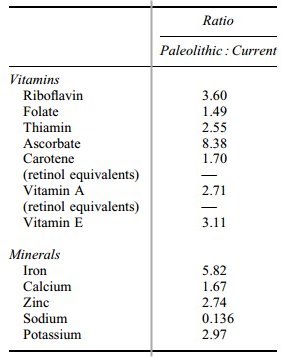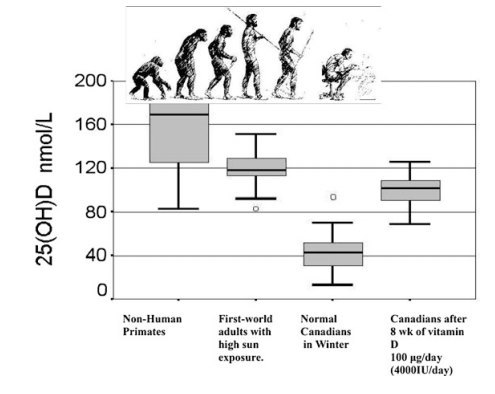Paleo Vitamin D, Vitamin C, Iron, Zinc, Potassium, etc were much higher
Paleolithic nutrition revisited: A twelve-year retrospective on its nature and implications - 1997
European Journal of Clinical Nutrition (1997) 51,207-216 © 1997
SB Eaton,1,2 SB Eaton III4 and MJ Konner1,3
1 Department of Anthropology, Emory University; 2Department of Radiology, 3 Department of Psychiatry, Emory University School of Medicine; and 4Department of Education, Marshall University
📄 Download the PDF from Vitamin D Life


The Paleolithic Nutrition Model in Relation to Ultraviolet Light and Vitamin D - Chapter 2020
Chapter in Sunlight, Vitamin D and Skin Cancer, Advances in Experimental Medicine and Biology 1268, https://doi.org/10.1007/978-3-030-46227-7_21
Reinhold Vieth Department of Laboratory Medicine and Pathobiology, and Department of Nutritional Sciences, Faculty of Medicine, University of Toronto, Toronto, ON, Canada e-mail: [email protected]

The biology of every species has been optimized for life in the environment in which that species evolved. Humans originated in the tropics, and while some natural selection took place in response to behaviors and environments that decreased exposure to ultraviolet light, there has never been a species-wide biological accommodation. Paleolithic nutrition advocates argue that risk of disease is higher because modem diets differ from what was consumed by early humans. Early humans were the naked ape living in the tropics, exposed to high levels of ultraviolet light and vitamin D nutrition (serum 25-hydroxyvitamin D; 25(OH)D) averaging 115 nmol/L, as compared to today’s population averages that are well below 70 nmol/L. Natural selection from an available gene pool cannot compensate fully to an environmental change away from the one within which the species originally evolved. Vitamin D nutrition remains a contentious area. The epidemiological evidence consistently relates lower 25 (OH)D to higher disease risk. However, evidence from double-blind clinical trials looking at preventing new disease in healthy volunteers has been disappointing. But such negative trials have been the case for all nutrients except for folic acid which lowers risk of spina bifida. The Paleolithic nutrition model is based on fundamental biological concepts, but it has overlooked the environmental effects of ultraviolet light and vitamin D nutrition. This paper presents evolutionary and Paleolithic aspects of ultraviolet light and vitamin D with the aim to support pertinent research and, ultimately, public policy regarding nutrition and light exposure.
📄 Download the PDF from Vitamin D Life
Vitamin D Life and Zinc
Zinc and Virus:
{category}
Zinc and Vitamin D category listing has items along with related searches
Vitamin D Life and Iron
Iron and Virus:
{category}
Iron has items along with related searches
Vitamin D Life and Vitamin C
Vitamin C and Virus:
{category}
Vitamin C category listing has items along with related searches
